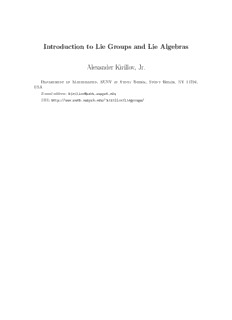Table Of ContentIntroduction to Lie Groups and Lie Algebras
Alexander Kirillov, Jr.
Department of Mathematics, SUNY at Stony Brook, Stony Brook, NY 11794,
USA
E-mail address: [email protected]
URL: http://www.math.sunysb.edu/~kirillov/liegroups/
Dedicated to my teachers
Contents
Preface 9
Chapter 1. Introduction 11
Chapter 2. Lie Groups: Basic Definitions 13
§2.1. Reminders from differential geometry 13
§2.2. Lie groups, subgroups, and cosets 14
§2.3. Analytic subgroups and homomorphism theorem 17
§2.4. Action of Lie groups on manifolds and representations 18
§2.5. Orbits and homogeneous spaces 19
§2.6. Left, right, and adjoint action 21
§2.7. Classical groups 21
Exercises 25
Chapter 3. Lie Groups and Lie algebras 29
§3.1. Exponential map 29
§3.2. The commutator 31
§3.3. Jacobi identity and the definition of a Lie algebra 33
§3.4. Subalgebras, ideals, and center 34
§3.5. Lie algebra of vector fields 35
§3.6. Stabilizers and the center 37
§3.7. Campbell–Hausdorff formula 39
§3.8. Fundamental theorems of Lie theory 40
§3.9. Complex and real forms 43
§3.10. Example: so(3,R), su(2), and sl(2,C). 44
Exercises 45
Chapter 4. Representations of Lie Groups and Lie Algebras 49
§4.1. Basic definitions 49
§4.2. Operations on representations 51
§4.3. Irreducible representations 52
5
6 Contents
§4.4. Intertwining operators and Schur’s lemma 54
§4.5. Complete reducibility of unitary representations. Representations of finite groups 55
§4.6. Haar measure on compact Lie groups 56
§4.7. Orthogonality of characters and Peter-Weyl theorem 58
§4.8. Representations of sl(2,C) 61
§4.9. Spherical Laplace operator and hydrogen atom 65
Exercises 68
Chapter 5. Structure Theory of Lie Algebras 71
§5.1. Universal enveloping algebra 71
§5.2. Poincare-Birkhoff-Witt theorem 73
§5.3. Ideals and commutant 75
§5.4. Solvable and nilpotent Lie algebras 76
§5.5. Lie’s and Engel’s theorems 78
§5.6. The radical. Semisimple and reductive algebras 80
§5.7. Invariant bilinear forms and semisimplicity of classical Lie algebras 82
§5.8. Killing form and Cartan’s criterion 83
§5.9. Jordan decomposition 85
Exercises 87
Chapter 6. Complex Semisimple Lie Algebras 89
§6.1. Properties of semisimple Lie algebras 89
§6.2. Relation with compact groups 90
§6.3. Complete reducibility of representations 91
§6.4. Semisimple elements and toral subalgebras 95
§6.5. Cartan subalgebra 97
§6.6. Root decomposition and root systems 97
§6.7. Regular elements and conjugacy of Cartan subalgebras 102
Exercises 104
Chapter 7. Root Systems 107
§7.1. Abstract root systems 107
§7.2. Automorphisms and Weyl group 108
§7.3. Pairs of roots and rank two root systems 109
§7.4. Positive roots and simple roots 111
§7.5. Weight and root lattices 113
§7.6. Weyl chambers 114
§7.7. Simple reflections 117
§7.8. Dynkin diagrams and classification of root systems 119
§7.9. Serre relations and classification of semisimple Lie algebras 123
§7.10. Proof of the classification theorem in simply-laced case 125
Exercises 127
Contents 7
Chapter 8. Representations of Semisimple Lie Algebras 131
§8.1. Weight decomposition and characters 131
§8.2. Highest weight representations and Verma modules 134
§8.3. Classification of irreducible finite-dimensional representations 137
§8.4. Bernstein–Gelfand–Gelfand resolution 139
§8.5. Weyl character formula 141
§8.6. Multiplicities 144
§8.7. Representations of sl(n,C) 145
§8.8. Harish-Chandra isomorphism 147
§8.9. Proof of Theorem 8.25 151
Exercises 152
Overview of the Literature 155
Basic textbooks 155
Monographs 155
Further reading 156
Appendix A. Root Systems and Simple Lie Algebras 159
§A.1. A =sl(n+1,C), n≥1 160
n
§A.2. B =so(2n+1,C), n≥1 161
n
§A.3. C =sp(n,C), n≥1 163
n
§A.4. D =so(2n,C), n≥2 164
n
Appendix B. Sample Syllabus 167
List of Notation 171
Index 173
Bibliography 175
Preface
This book is an introduction to the theory of Lie groups and Lie algebras, with emphasis on the
theory of semisimple Lie algebras. It can serve as a basis for a two semester graduate course or —
omitting some material — as a basis for a rather intensive one semester course. The book includes
a large number of exercises.
The material covered in the books ranges from basic definitions of Lie groups to the theory of
root systems and highest weight representations of semisimple Lie algebras; however, to keep book
size small, structure theory of semisimple and compact Lie groups is not covered.
Exposition follows the style of famous Serre’s textbook on Lie algebras [47]: we tried to make
the book more readable by stressing ideas of the proofs rather than technical details. In many
cases, details of the proofs are given in exercises (always providing sufficient hints so that good
studentsshouldhavenodifficultycompletingtheproof). Insomecases,technicalproofsareomitted
altogether;forexample,wedonotgiveproofsofEngel’sorPoincare–Birkhoff–Witttheorems,instead
providing an outline of the proof. Of course, in such cases we give references to books containing
full proofs.
Itisassumedthatthereaderisfamiliarwithbasicsoftopologyanddifferentialgeometry(mani-
folds,vectorfields,differentialforms,fundamentalgroups,coveringspaces)andbasicalgebra(rings,
modules). Some parts of the book require knowledge of basic homological algebra (short and long
exact sequences, Ext spaces).
Errata for this book are available on the book web page at
http://www.math.sunysb.edu/~kirillov/liegroups/.
9
Description:Dedicated to my teachers . This book is an introduction to the theory of Lie groups and Lie algebras, with emphasis on the turns out that in many ways such groups can be described and studied as easily as finitely generated.

